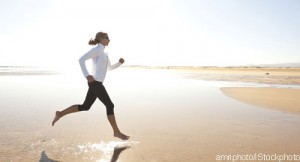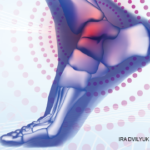 Running barefoot may conjure images of summer and childhood, but since Abebe Bikila of Ethiopia set a world record running barefoot in the marathon in the 1960 Olympic Games in Rome (Olympic gold medal in a world-record 2:15:16.2), many runners have adopted the style. A comparison of shod and barefoot running indicates that, although the two running strategies have similar injury rates, barefoot running may be associated with significantly fewer overall musculoskeletal (MSK) injuries.
Running barefoot may conjure images of summer and childhood, but since Abebe Bikila of Ethiopia set a world record running barefoot in the marathon in the 1960 Olympic Games in Rome (Olympic gold medal in a world-record 2:15:16.2), many runners have adopted the style. A comparison of shod and barefoot running indicates that, although the two running strategies have similar injury rates, barefoot running may be associated with significantly fewer overall musculoskeletal (MSK) injuries.
Allison Altman-Singles, PhD, an assistant professor of kinesiology and mechanical engineering at Pennsylvania State University Berks in Reading, and Irene S. Davis, PhD, a professor of physical medicine and rehabilitation at Harvard Medical School in Cambridge, Mass., published the results of their prospective survey in the April 2016 issue of the British Journal of Sports Medicine.1 “We aren’t seeing more musculoskeletal injuries in barefoot runners,” explains Dr. Altman-Singles in an interview with The Rheumatologist. “If anything, we are seeing fewer of certain types of musculoskeletal injuries.”
The researchers examined the differences in injuries between habitually barefoot and habitually shod runners. They categorized participants as barefoot runners if individuals spent at least 50% of their running time barefoot. Barefoot runners were allowed to run in minimalist footwear for the balance of their running time. In many cases, barefoot runners had experienced injuries, such as fasciitis and iliotibial band syndrome (ITBS), prior to switching to barefoot running.
Barefoot Runners Ran Fewer Miles
The investigators noted in their paper that the barefoot runners tended to be older than the shod runners (38.6 vs. 34.6 years). Additionally, barefoot runners ran shorter distances. Robert K. Lee, DPM, chief of podiatric foot and ankle surgery at the UCLA Medical Center in Santa Monica, Calif., believes this difference in mileage between the two groups was a fatal flaw of the study.
“The barefoot runners, in this study, ran on average 10 miles less per week compared [with] the runners with shoes. In fact, the barefoot runners averaged about 15 miles per week, whereas the shoe runners ran 25 miles per week. That means the latter group ran 66% more miles compared [with] the barefoot group,” writes Dr. Lee in an email to The Rheumatologist.
The data add up to an average of 520 more miles per year run by each of the shod runners when compared with barefoot runners.
In an apparent acknowledgement of this mileage difference, the authors reported their data as injury rate. When the investigators looked more closely at the types of injuries sustained by each group they found that, in both groups of runners, the foot was the most commonly injured area. Dr. Lee was not surprised to discover that, although the injury rate was similar between the two groups, the group with more miles had more foot issues. However, the type of foot injuries differed between the two groups. The barefoot runners were more likely to experience plantar surface injuries and abrasive injuries to the sole of the foot than were the shod runners.
